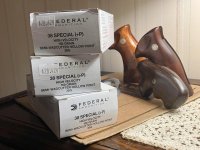agent00
Member
I am looking for new ammo to try out in my smith wesson model 27-2.
For self defense purposes I prefer to use 38 special rounds indoors for self defense. Full mag loads would be a bit overkill.
The .38 Special LSWCHP +P should offer more than enough performance needed.
As a history buff I am interested in .38 Special LSWCHP +P FBI load.
I wonder if any of the available loads are close to the "original" specs or not?
For self defense purposes I prefer to use 38 special rounds indoors for self defense. Full mag loads would be a bit overkill.
The .38 Special LSWCHP +P should offer more than enough performance needed.
As a history buff I am interested in .38 Special LSWCHP +P FBI load.
I wonder if any of the available loads are close to the "original" specs or not?

